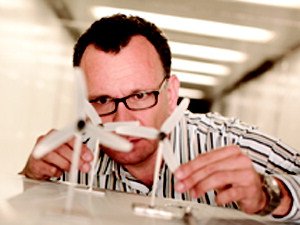Going With the Flow

For Fotis Sotiropoulos, it's about being at the right place at the right time
Ships, river restoration projects, wind turbines, bridge abutments, mackerels and heart valves may not, at first blush, seem to have a lot in common. But they all share the common trait of fascinating Fotis Sotiropoulos.Turbulent times
Professor of civil engineering and director of the St. Anthony Falls Laboratory in the University of Minnesota's College of Science and Engineering, Sotiropoulos studies all things turbulent. As it turns out, that’s pretty much all things. Wherever fluids meet physical forces, whether in a bloodstream, trout stream or airstream, seemingly unpredictable things happen. Sotiropoulos uses principles of fluid mechanics, supercomputers, and sophisticated computational software to predict them – to the benefit of better biomedical devices, healthier aquatic habitats, more stable engineering structures, and improved efficiency in tapping renewable energy sources like wind and water power. And he has fun in the process.
“I like personally to follow exciting problems wherever they lead you,” Sotiropoulos says. “I’ve always tried to go after problems that are exciting, that require some more high-level fluid mechanics research and expertise, and are also important from a societal point of view.”
From Greece to Minnesota
Born in Athens, Greece, Sotiropoulos remembers being captivated early on by the swirling patterns water traces as it flows downstream, and by the ability of ships, planes, birds, and fish to propel themselves in a fluid environment. After earning degrees in mechanical and aerospace engineering, he worked first at the Iowa Institute of Hydraulic Research, then joined the faculty of Georgia Institute of Technology, where he applied his knowledge of fluid mechanics to exploring topics ranging from how biomedical devices work to how plankton swim.
"I've always tried to go after problems that are exciting, that require some more high-level fluid mechanics research and expertise, and are also important from a societal point of view." Fotis Sotiropoulos
When he moved to Minnesota in 2006 to head the St. Anthony Falls Laboratory, Sotiropoulos’ first job was to find a new research focus for the world-renowned facility. With the wind blowing strong overhead, the Mississippi River rushing past his office window, and the search for renewable alternatives to fossil fuels ramping up around the world, he recommended the lab join the quest for better ways to apply nature’s power sources to meeting human needs.
“There are many problems in the area of renewable energy where fluid mechanics is important,” Sotiropoulos says. “looking at this, we realized that St. Anthony Falls Laboratory could be a leader in a wide range of renewable energy problems where they intersect with fluid mechanics problems, whether it’s wind energy, hydropower or biodiesel production.”
Energizing new research
Sotiropoulos found an ally for his efforts in the University’s Initiative for Renewable Energy and the Environment. In 2008, IREE provided matching funding to leverage a $1 million grant from Xcel Energy aimed at discovering how wind farms can be strategically configured so disruptions individual turbines cause to airflow can boost rather than reduce overall power production. Shortly afterward, IREE funds help Sotiropoulos snag $400,000 in U.S. Department of Energy funding to help design a pilot underwater turbine system for generating electricity from the energy in flowing water—a system that’s currently being pilot-tested in New York City’s East River.
Last year, when DOE invited proposals to build and study a large-scale experimental turbine and educate next-generation wind power experts as part of its initiative to get 20 percent of U.S. electricity from wind by 2030, Sotiropoulos was primed for success. With IREE’s assistance, he put together a proposal with eight industry collaborators that led to a successful application and an $8 million grant.
“We were at the right time at the right place with the right resources,” Sotiropoulos says.
Sotiropoulos loves the intellectual intrigue of fluid dynamics: Computational flow modeling to him is what a word puzzle or Rubik’s cube might be to the rest of us. At the same time, he appreciates the opportunity to provide practical value.
"What gives me a lot of excitement at the personal level is on one hand staying very much involved in my research, but also this opportunity to impact things at the national level—by bringing together big collaborations and getting the industry and the University together and really go after the problems of major societal relevance," he says. "Ultimately, the true measure of success is, what do you give back?"
For more information about the St. Anthony Falls Laboratory, visit safl.umn.edu.
Reprinted with permission from Momentum magazine, University of Minnesota Institute on the Environment.
